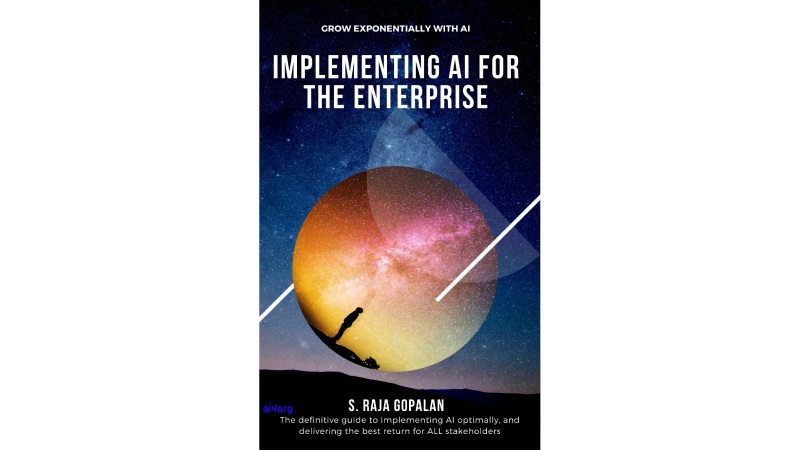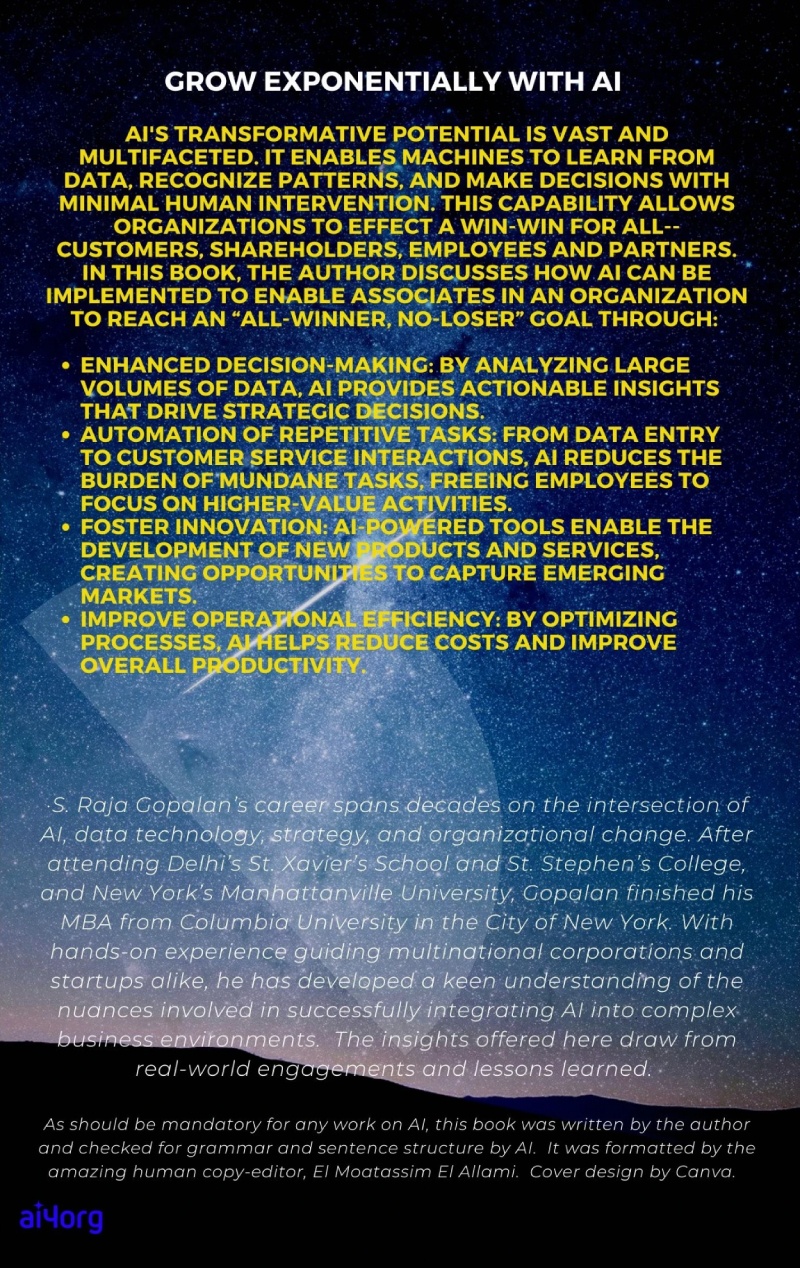James Moynihan, Contributing Writer

Implementing AI for the Enterprise by S. Raja Gopalan is a 2024 release on Amazon, a pragmatic and hands-on guide to deploying artificial intelligence (AI) at the enterprise level. Unlike most other books on AI, this work is targeted at business professionals, executives, and decision-makers who need to understand how to implement AI effectively rather than just conceptualize its potential. The book walks readers through the strategic, operational, and technical challenges of AI adoption and provides frameworks, case studies, and best practices to ensure a successful AI transformation.
The book is structured into multiple sections, each focusing on different aspects of AI implementation. The introduction sets the stage by discussing how AI is transforming not just business but entire industries. It highlights the importance of good data, addresses AI’s challenges, and frames AI as a tool for enhancing business operations rather than replacing human workers.
In terms of strategic AI Implementation, Implementing AI for the Enterprise advises readers to first identify the right areas where AI can drive impact. It starts with the role of the CEO/CFO/VPs and equivalent-level executives to align AI with business objectives. It then discusses how to enhance revenue through AI-driven innovation and optimizing pricing, customer insights, and hyper-targeted advertising. It also provides insights on AI’s role in reducing operational costs, improving process automation, and strengthening supply chains.
The next section discusses how to create a framework to identify AI opportunities and map them to business returns. It reviews industry-specific applications, from predictive maintenance in manufacturing to fraud detection in finance and AI-driven HR optimization.
The book also shows how the success of artificial intelligence (AI) initiatives is deeply intertwined with the quality and management of data. High-quality, clean data is essential for training accurate and reliable AI models, as it ensures that the algorithms can learn effectively and make precise predictions. Moreover, possessing proprietary data can serve as a significant competitive advantage, providing unique insights that are not accessible to competitors. Implementing robust data governance strategies is crucial to maintain data integrity, ensure compliance with relevant regulations, and protect sensitive information from breaches. By focusing on these aspects, organizations can enhance the effectiveness of their AI deployments and achieve better outcomes.
The book then move to transitioning from isolated AI applications to a comprehensive, organization-wide AI strategy is essential for enterprises aiming to fully leverage artificial intelligence. This shift involves adopting AI platforms, utilizing cloud-based AI tools, and implementing Machine Learning Operations (MLOps) to facilitate enterprise-wide AI deployment. A critical aspect of this integration is dismantling data silos, ensuring that AI is seamlessly incorporated across various business functions to enhance efficiency and decision-making.
In sharp contrast to most other books, the author discusses another aspect of AI. He points out that AI also presents significant challenges and risks that organizations must address to ensure secure and ethical deployment. One prominent concern is the emergence of deepfakes—highly realistic but fabricated audio and visual content generated using AI. These can be misused for impersonation, misinformation, and fraud, posing threats to data privacy and security. For instance, deepfakes have been utilized to impersonate company executives, leading to unauthorized financial transactions.
Additionally, Gopalan points out that AI can be exploited to enhance cyberattacks. Threat actors may use AI to identify and exploit vulnerabilities more efficiently, create sophisticated phishing schemes, or develop adaptive malware that evades traditional security measures. The accessibility of AI tools lowers the barrier for such malicious activities, increasing the scale and speed of potential attacks.
To mitigate these risks, the author recommends that organizations should implement robust strategies, including adopting zero-trust architectures that require continuous verification of user identities and access privileges. Deploying advanced detection tools capable of identifying deepfake content is also crucial. Regular risk assessments, employee training on AI-related threats, and establishing clear policies for AI use can further strengthen an organization’s defense against the “dark side” of AI.
The author then looks at the future and points out that the future of artificial intelligence (AI) in enterprises is poised to significantly influence decision-making processes, ethical frameworks, and regulatory landscapes. As AI systems become more integral to business operations, they are expected to enhance data-driven decision-making by providing rapid, precise insights, thereby increasing efficiency and fostering innovation. However, this integration necessitates careful consideration of ethical issues, such as algorithmic bias, data privacy, and the need for transparency in automated decisions. Regulatory bodies are actively developing frameworks to ensure responsible AI deployment, aiming to balance technological advancement with societal values. Consequently, organizations must commit to continuous learning and adaptation in their AI strategies, staying informed about evolving ethical standards and regulatory requirements to responsibly harness AI’s transformative potential.
Strengths of the Book
Unlike many AI books that focus on high-level concepts, this book offers a pragmatic and practical roadmap for enterprises. It discusses offers a business-oriented approach, with real-world applications, decision-making frameworks, and common pitfalls rather than just theoretical AI capabilities. It is tailored for executives, business professionals, and decision-makers rather than AI researchers or developers. The discussion remains accessible while covering financial, strategic, and operational dimensions of AI adoption.
One of the book’s strongest elements is its real-world examples and case studies drawn from industries such as finance, retail, manufacturing, and healthcare. These examples help illustrate how AI can be applied in practical scenarios rather than remaining an abstract concept.
The book also dedicates significant attention to data governance, proprietary data advantages, and AI-driven decision support. This focus aligns well with real-world enterprise AI challenges, offering a way out for AI projects that fail due to poor data quality rather than inadequate models.
Additionally, the book does not glorify AI blindly. Instead, it offers a balanced perspective on the risks of AI misuse, deepfakes, and cybersecurity vulnerabilities. The discussion on AI ethics, transparency, and regulatory challenges is particularly timely and relevant.
Areas for Improvement
The book could still benefit from changes in some areas. While the author did say that the book is business-focused, adding more technical depth to some sections could widen its reach for a little extra effort. For instance, discussions on MLOps, data engineering, or AI model evaluation frameworks could be expanded for readers who may be overseeing technical AI teams.
The book contains useful insights, but it could enhance its value by providing more structured frameworks, templates, or checklists for AI adoption. A “step-by-step guide” for AI project implementation, or an accompanying workbook, would be particularly useful. Also, the book has limited coverage of small and medium enterprises (SMEs). Most case studies focus on large enterprises with significant AI budgets. A section on AI implementation for SMEs or “AI on a budget” would make the book more inclusive for businesses with limited AI expertise or resources.
The book would also benefit from a greater focus on change management. AI adoption is not just a technical challenge—it involves organizational change management, employee reskilling, and executive buy-in. While the book discusses these topics to some extent, a dedicated chapter on “AI Change Management” could enhance its practical relevance.
Also, since AI evolves rapidly, some case studies and examples might feel outdated within a few years. So future editions will need to reflect those changes.
Final Assessment
| Criteria | Rating (Out of 5) |
| Clarity & Readability | ★★★★★ (5.0) |
| Practical Business Insights | ★★★★★ (5.0) |
| Technical Depth | ★★★★★ (5.0) |
| Technical Depth | ★★★☆☆ (3.5) |
| Use of Case Studies | ★★★★★ (5.0) |
| Relevance to Enterprise AI | ★★★★★ (5.0) |
| Coverage of AI Risks & Ethics | ★★★★★ (5.0) |
| Change Management & Organizational Readiness | ★★★★☆ (4.0) |
“Implementing AI for the Enterprise” is a must-read for business leaders excellent resource for executives, decision-makers, and business strategists looking to harness AI in a structured, impactful way. It provides actionable insights, case studies, and a risk-aware perspective that makes AI adoption more accessible and business-relevant.
However, it is not a deep technical guide for AI engineers or data scientists. Those seeking hands-on coding, algorithmic deep dives, or model deployment techniques will need to supplement this book with more technical resources.
Overall, S. Raja Gopalan succeeds in delivering a pragmatic, balanced, and insightful guide to AI in the enterprise. The book is highly recommended for C-suite executives, business leaders, and AI transformation teams looking to make AI work at scale.
Final Rating: 4.7/5 – A Strategic Must-Read for AI Business Leaders.

This article, written by James Moynihan, was published by August Roberts.